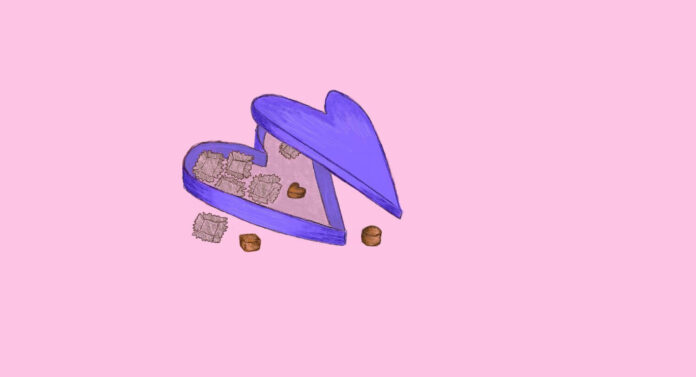For many, the first two weeks of February are full of promise and love. For others, it’s a time full of bitterness and resentment. Personally, Valentine’s Day doesn’t necessarily make me feel bad — as a single person for the past 19 years, I’ve found the idea of Valentine’s Day extremely cute and amazing. Every year, I bake my friends heart-shaped cookies and watch classics like “Love, Actually”, “13 Going on 30” and “10 Things I Hate About You” alone in my room. It’s a peaceful night for me, and I love eating pink and red goods while I think about the idea of love.
A couple of weeks ago, I ran to the local Target as one does to buy some groceries. As I was frolicking down the aisles, I found the glorious pink stand, adorned with heart-shaped marshmallows and pink baking sets. I love dilly-dallying at Target, especially during holiday seasons — you know I couldn’t resist. I floated towards the section as if I was possessed, man-handling all the Valentine’s card packs and cheap candies in cardboard heart boxes. After my trip, I felt satisfied as I sat in the car, inhaling the pink Kit-Kat bars and caressing my felt animals that I bought as decoration for my dorm. But then it hit me. I don’t love love — I love the way we as a society commercialize love.
Ever since I was little, there has been a consistent form of marketing for all holidays, and Valentine’s Day is no exception. Since the 1800s, many businesses have profited from the holiday, with common products ranging from chocolate boxes to cards and flowers. However, the industry for this love-filled holiday has skyrocketed. For the fiscal year of 2023, Valentine’s Day spending for consumers in the US is expected to be $26 billion, a whopping $2 billion more from last year’s spending.
The holiday, however, took a significant blow during the COVID-19 pandemic. According to Statista, sales dropped from $27.8 billion to $21.8 billion from 2020 to 2021. Everyone during this time was affected, reporting thoughts of loneliness and lack of social interaction. However, young people were hit the hardest — 61 percent of young adults from ages 18-25 reported feeling high levels of loneliness. With a lack of connection to the physical world and an ever-growing media-centered society, it makes sense that young, growing adults felt an increase in sadness during the pandemic. Now that we are slowly putting back the pieces of “pre-pandemic” life together, it also makes sense that there is a sales spike in Valentine’s Day each year since 2020. Many people probably feel the need to make up for lost time, and savor every aspect of life, even if it’s just chocolates on the shelf at Walgreens.
Let’s be honest: this kind of marketing makes people feel nostalgic. Similar to how the smells of Disneyland can bring back memories of childhood, the memories or ideas associated with Valentine’s Day make us gravitate towards it, despite its commercialization. Even if we have never experienced love or the holiday on a more intimate level, many, including myself, can’t stay away from at least examining the themed aisles and grabbing a candy or two. I feel transported back to my years in elementary school, where all of my classmates would give each other valentines, sorting and trading the cards we got each time. The routine marketing of the holiday feels like clockwork, as it’s something to look forward to and anticipate every year. Even in film, books and media, we use love as a standing point to entice the audience — love excites. It makes people feel things, whether it be hope or anguish, or about the one person who left your message on read. Similar to these forms of media, the commodification of Valentine’s day can give the same feeling. If single people do not have any plans to go on a date, why not give them some candy? It releases the same chemical, anyway.
Especially right now, in a world recuperating from the long-term effects of isolation and lack of social interaction, Valentine’s Day is a symbol of joy and hope. More than ever, people need to be shown how much they’re appreciated and loved. This holiday can be a good example of just that and how important it is to feel good about yourself and the connections you have with others. So next time you catch me stuffing my face with Pillsbury heart shaped cookies, mind your own business.
![]()



































